From spare parts on demand to click-and-buy tenders, 3D printing is transforming how boats are designed and built, discovers Tristan Rutherford
Espen Øino holds a 3D-printed model of a yacht up to his laptop camera. “We use 3D printing for quickly printing out models to evaluate,” explains the celebrated naval architect. “The more you look at a virtual model on a screen the more you feel the need to physically touch it and feel how the hull shape is.”
Øino states that 3D printing “is going to revolutionise boatbuilding”. Circuitry could be printed inside a hull without cable trays. Local geometries and structural arrangements will not be based upon accessibility for a welder or engineer to do their job. “It’s really promising because once we have different printing heads with different materials you can optimise structures.” The timescale? “Don’t get too excited,” warns Øino. Printing entire superyachts are still some way off.

RISE, Research Institute of Sweden
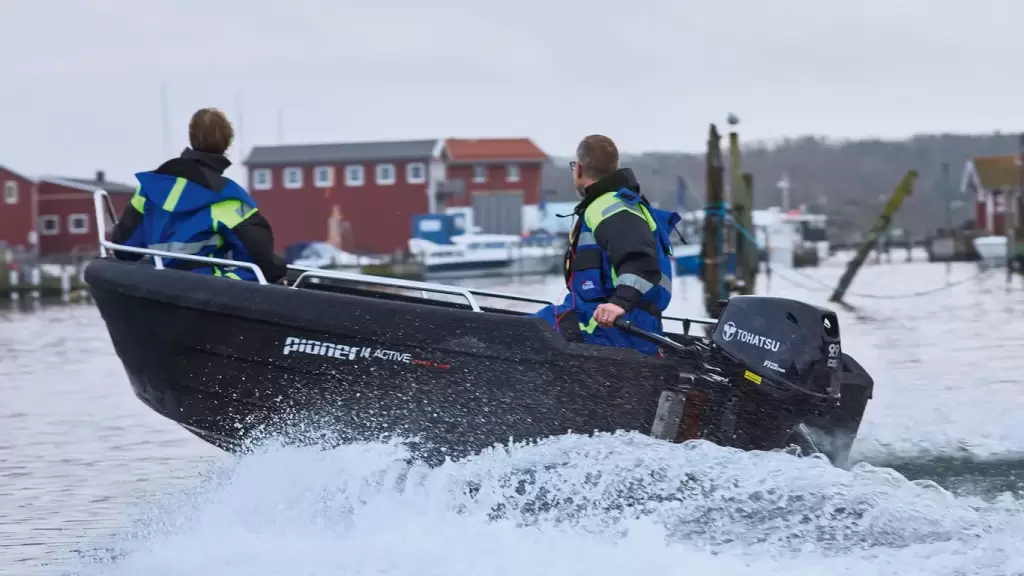
This Pioner 14 Active hull was printed at the RISE Research Institute in three days. Credit: Anna Hult
Also last December, Rotterdam startup Tanaruz clicked “print” on the tender of the future. Tanaruz’s runabouts (from €15,000, and 4.5 metres to 7.5 metres in length) look like the eco-chic offspring Nike and Apple, with swooshing lines and ice-white interiors. The range envisions a voyage without fossil fuels. Solar panels are seamlessly integrated into the boat’s design and can maintain the digital display, trip data and 48V electric engines, which are backed up with a rechargeable battery. The company’s third hull, printed in March 2022, putters down the Rotte River at its top speed of six knots.
Tanaruz imagines a Tesla-like world without brokers too: models are customised via an app (toggle to vary length, colour, cushions and power pack) then delivered by truck two weeks later across Europe.
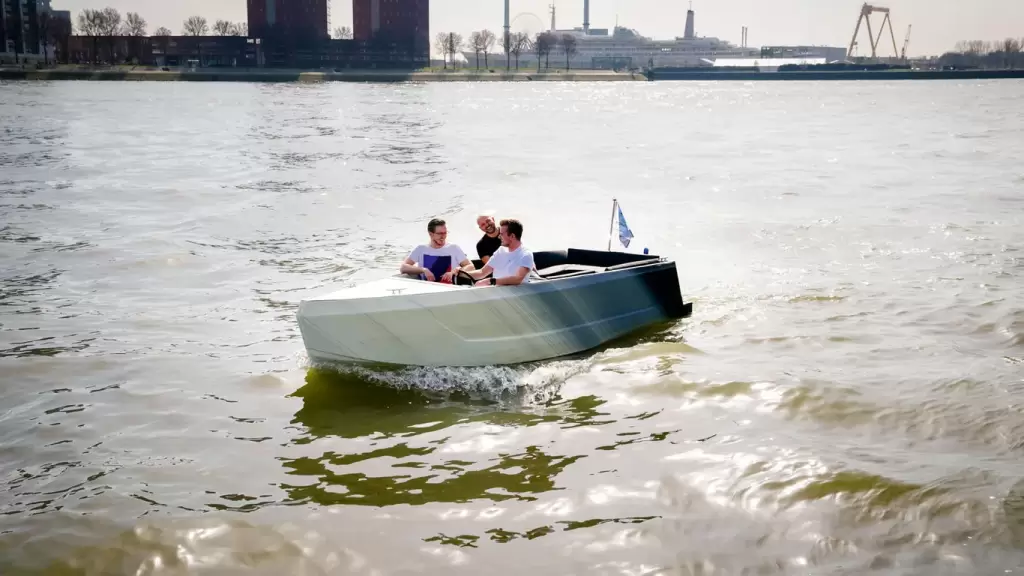
Tanaruz prints runabouts from 4.5m to 7.5m. Credit: Chris Peters
Naval architect and Tanaruz co-founder Alexey Shifman explains the allure. “With 3D printing, I don’t need welders or specialists with different knowledge,” he asserts. “I don’t need to build a shipyard; [all that’s required is] one or two people working around a printer.” In the 3D future, bigger boats won’t blow the budget. “With a GRP boat, if you go from five to 10 metres you need four times more people. If we printed bigger it simply doesn’t matter.”
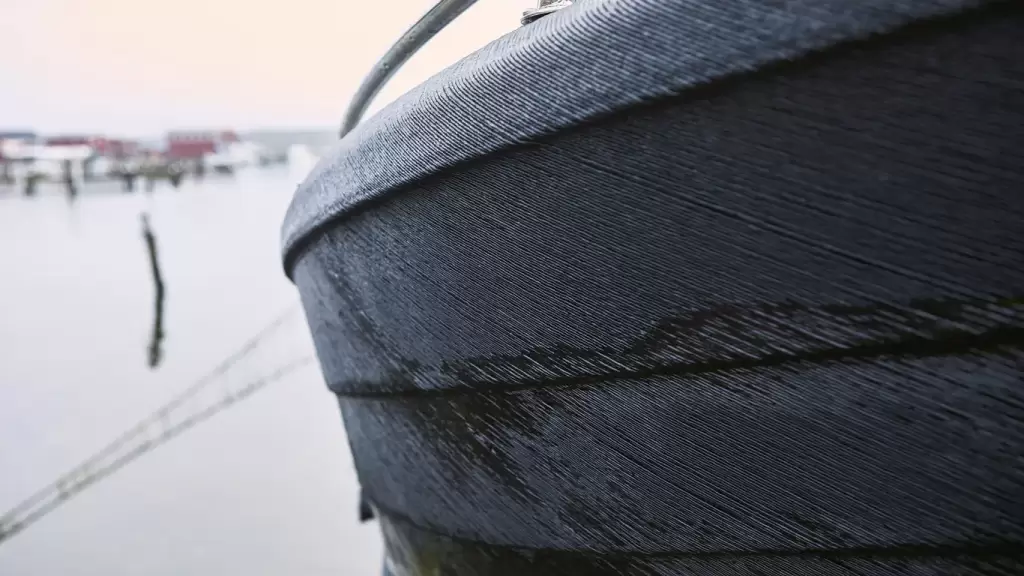
Credit: Anna Hult
Here’s the fun bit. “We can shred and reuse each Tanaruz boat five times,” explains Shifman. “A client can recycle a boat back to us to reprint into one that’s bigger, smaller, a different colour or design for a small fee. It’s a closed circle.” With Tanaruz’s tech, it would be practical to change your little electric tender every couple of years.
Across the Netherlands, Feadship uses 3D printing to speed up the production process, says lead exterior engineer Jitze van Zelst. “More than 10 years ago we started with small items.” In particular objects that took too long to produce elsewhere or were tricky to procure by other means, like bespoke stainless-steel fittings for a railing. “On one recent yacht we installed 100 of these 3D-printed brushes for cabinet door knobs,” continues van Zelst. Feadship owns its own printers and a network of 3D-printing specialists. “In the future, crew might be able to print their own spare parts on board.”
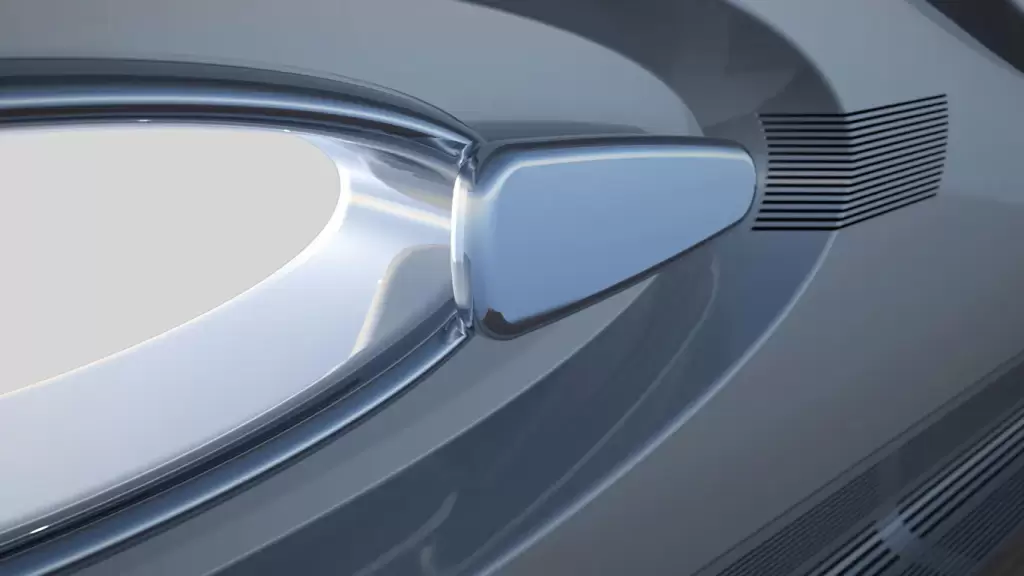
Hawse detail. Credit: Gregory C Marshall
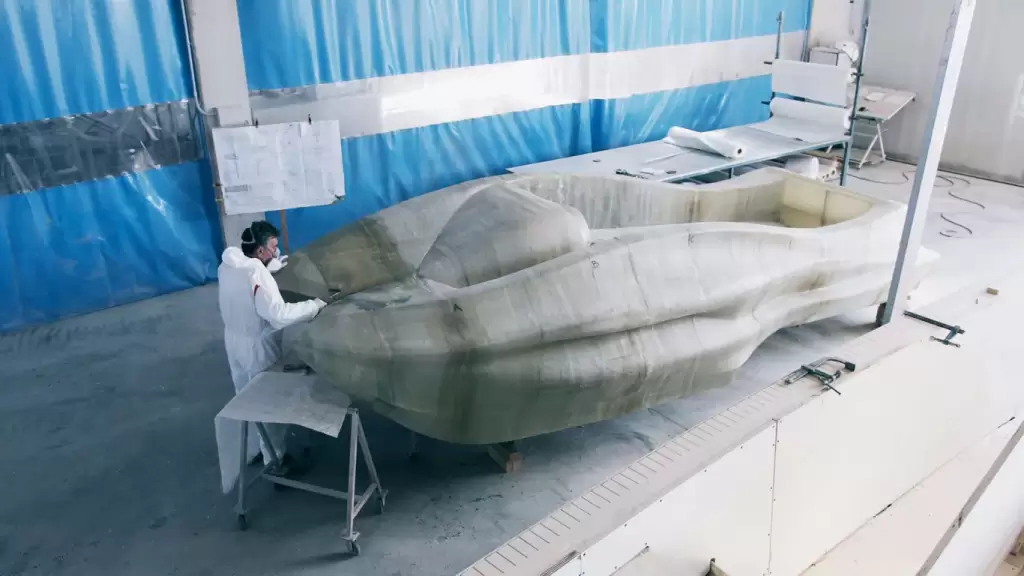
MAMBO is a sculptural craft, crafted by robots. Credit: Moi Composites
There’s a second factor in the metal printing stakes. As materials are used so sparingly during the printing process, “in the next 10 years” printers might be able to produce an entire boat from titanium, which has the greatest strength-to-density ratio of any metallic element. “Because titanium doesn’t corrode, all of a sudden you can make tiny little pipes to do all sorts of things,” continues Marshall. These include “drain details in the decks themselves or miles and miles of cooling lines that take seawater, blow it through the boat, and keep all the decks cool.” The technology is already there to print hinges on doors or sinks in the heads, with the possibility to physically print wiring into a boat so that a shipyard doesn’t have to draw cables. To build a full-sized boat, “what you have to do is increase the size of the machine. That’s just a scaling thing.”
Printing in metal opens up other opportunities. “We can go down to three microns (.003mm),” explains Marshall. This creates the quality of production in terms of measurement and cutting that one might expect on an iPhone and a more complex finish possible than on a GRP-moulded boat. Better still, if a designer wishes to colourise their titanium prior to printing, a paint job could become a thing of the past.
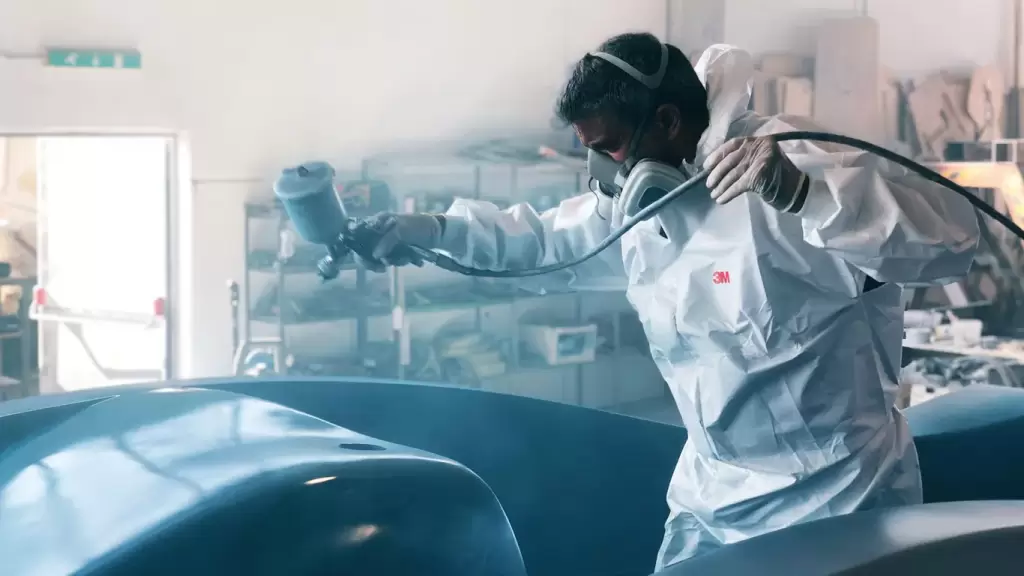
Credit: Moi Composites
What about the holy grail of 3D printing on board a yacht? “They just loaded [a 3D printer] on one of the big aircraft carriers,” he continues. “It’s not an inexpensive way to produce parts, but if you’re in Antarctica and you don’t have a choice…”
In Milan, printing experts Moi Composites have floated yet another 3D business model: bringing the latest printing deck directly to shipyards. The backstory is that three sea-loving scientists spent years creating their own specialist printing materials. These are mainly based around fibreglass, carbon fibre or Kevlar, mixed with a resin that solidifies directly after printing – imagine the world’s most expensive printer cartridge. Other firms have struggled with generic plastics. Their conventional printers melt coils of plastic that harden slowly and frequently get doused in the dust – a nightmare in terms of finish.
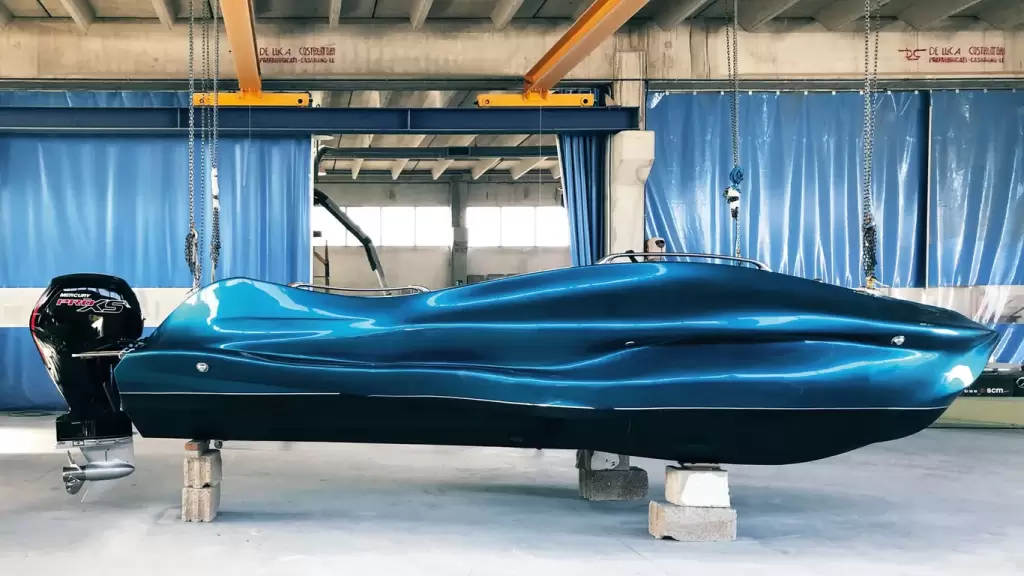
MAMBO was created by Moi Composites as a showpiece for 3D printing, Credit: Moi Composites
“Our materials are also much stronger and more lightweight, as well as resistant to chemicals and heat,” says Moi Composites’ chief technical officer Michele Tonizzo. To prove it, they printed a one-of-a-kind boat called MAMBO for the Genoa Boat Show in 2020. The vessel is a wave-like sculpture capable of 26 knots, crafted by robots that worked through the night to push nautical engineering to the limit. “It’s not supposed to look conventional,” says Tonizzo, but more of a showpiece of what 3D-printing technology can produce. “[MAMBO] is elegant, crazy, and it would have been impossible to achieve with normal methods.”
Could a shipyard send Moi Composites a set of naval architect drawings to print out? “We did a project with Sanlorenzo to produce parts for its newly designed boat and shorten the time to market,” Tonizzo says. “We are also enabling manufacturers to print parts by themselves by providing them with our 3D-printing system.”
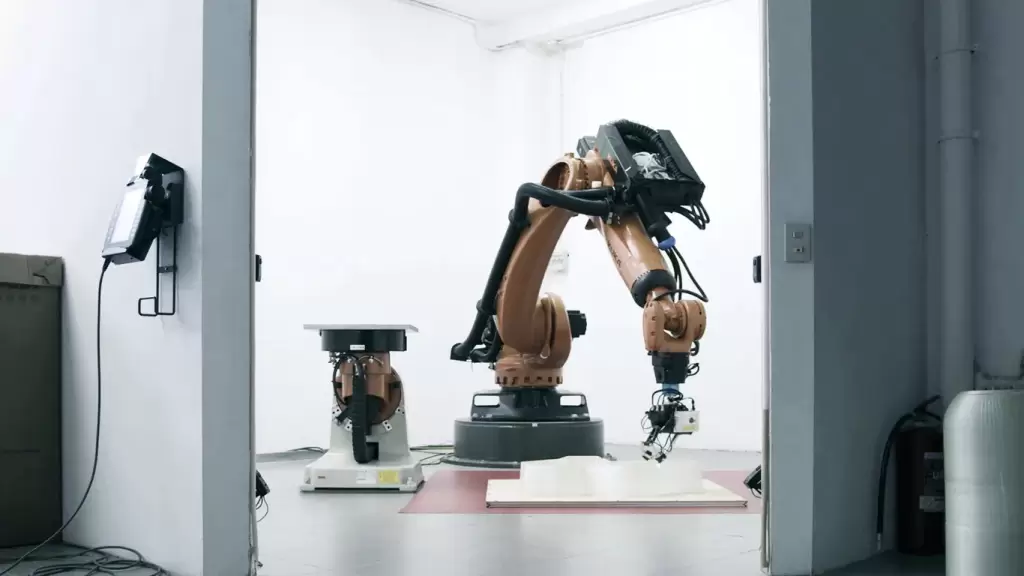
Credit: Moi Composites
From spare parts on demand to click-and-buy tenders, 3D printing is transforming how boats are designed and built, discovers Tristan Rutherford
Espen Øino holds a 3D-printed model of a yacht up to his laptop camera. “We use 3D printing for quickly printing out models to evaluate,” explains the celebrated naval architect. “The more you look at a virtual model on a screen the more you feel the need to physically touch it and feel how the hull shape is.”
Øino states that 3D printing “is going to revolutionise boatbuilding”. Circuitry could be printed inside a hull without cable trays. Local geometries and structural arrangements will not be based upon accessibility for a welder or engineer to do their job. “It’s really promising because once we have different printing heads with different materials you can optimise structures.” The timescale? “Don’t get too excited,” warns Øino. Printing entire superyachts are still some way off.

RISE, Research Institute of Sweden
Last December the excitement was palpable as one of Scandinavia’s best-selling runabout models powered along Sweden’s blustery west coast. But this version of the 4.2-metre Pioner 14 Active was different. It had been printed in just three days, entirely in one piece. No moulds, no tools and minimal labour required. The build wasted just four per cent of raw material. The boat could have been printed in sky blue or shocking pink. The style-conscious Swedes chose black.
In the three leading yacht manufacturing nations of Italy, the Netherlands and Turkey, dozens of designers, shipyards and service companies are using 3D printers to create models, parts and entire boats in very different ways. It’s a fragmented market buzzing with ideas, yet one that’s breaking convention with every passing month.

This Pioner 14 Active hull was printed at the RISE Research Institute in three daysCredit: Anna Hult
Also last December, Rotterdam startup Tanaruz clicked “print” on the tender of the future. Tanaruz’s runabouts (from €15,000, and 4.5 metres to 7.5 metres in length) look like the eco-chic offspring Nike and Apple, with swooshing lines and ice-white interiors. The range envisions a voyage without fossil fuels. Solar panels are seamlessly integrated into the boat’s design and can maintain the digital display, trip data and 48V electric engines, which are backed up with a rechargeable battery. The company’s third hull, printed in March 2022, putters down the Rotte River at its top speed of six knots.
Tanaruz imagines a Tesla-like world without brokers too: models are customised via an app (toggle to vary length, colour, cushions and power pack) then delivered by truck two weeks later across Europe.

Tanaruz prints runabouts from 4.5m to 7.5mCredit: Chris Peters
Naval architect and Tanaruz co-founder Alexey Shifman explains the allure. “With 3D printing, I don’t need welders or specialists with different knowledge,” he asserts. “I don’t need to build a shipyard; [all that’s required is] one or two people working around a printer.” In the 3D future, bigger boats won’t blow the budget. “With a GRP boat, if you go from five to 10 metres you need four times more people. If we printed bigger it simply doesn’t matter.”

Credit: Anna Hult
Here’s the fun bit. “We can shred and reuse each Tanaruz boat five times,” explains Shifman. “A client can recycle a boat back to us to reprint into one that’s bigger, smaller, a different colour or design for a small fee. It’s a closed circle.” With Tanaruz’s tech, it would be practical to change your little electric tender every couple of years.
Across the Netherlands, Feadship uses 3D printing to speed up the production process, says lead exterior engineer Jitze van Zelst. “More than 10 years ago we started with small items.” In particular objects that took too long to produce elsewhere or were tricky to procure by other means, like bespoke stainless-steel fittings for a railing. “On one recent yacht we installed 100 of these 3D-printed brushes for cabinet door knobs,” continues van Zelst. Feadship owns its own printers and a network of 3D-printing specialists. “In the future, crew might be able to print their own spare parts on board.”

Hawse detailCredit: Gregory C Marshall
Note that most yacht spares will have to be printed in metal, which comes at a cost. While a 30-centimetre-long resin printer can be snapped up for €2,500, a similar-sized unit to print in aluminium or stainless steel can easily touch half a million euros. Yet 3D-printing converts state that the process is like printing money. Firstly as there is so little waste, and secondly as so little material is needed because handrails, drains and other deck items can have an 80 per cent hollow latticework interior, thereby paving the way for lighter boats too.

MAMBO is a sculptural craft, crafted by robotsCredit: Moi Composites
There’s a second factor in the metal printing stakes. As materials are used so sparingly during the printing process, “in the next 10 years” printers might be able to produce an entire boat from titanium, which has the greatest strength-to-density ratio of any metallic element. “Because titanium doesn’t corrode, all of a sudden you can make tiny little pipes to do all sorts of things,” continues Marshall. These include “drain details in the decks themselves or miles and miles of cooling lines that take seawater, blow it through the boat, and keep all the decks cool.” The technology is already there to print hinges on doors or sinks in the heads, with the possibility to physically print wiring into a boat so that a shipyard doesn’t have to draw cables. To build a full-sized boat, “what you have to do is increase the size of the machine. That’s just a scaling thing.”
Printing in metal opens up other opportunities. “We can go down to three microns (.003mm),” explains Marshall. This creates the quality of production in terms of measurement and cutting that one might expect on an iPhone and a more complex finish possible than on a GRP-moulded boat. Better still, if a designer wishes to colourise their titanium prior to printing, a paint job could become a thing of the past.

Credit: Moi Composites
What about the holy grail of 3D printing on board a yacht? “They just loaded [a 3D printer] on one of the big aircraft carriers,” he continues. “It’s not an inexpensive way to produce parts, but if you’re in Antarctica and you don’t have a choice…”
In Milan, printing experts Moi Composites have floated yet another 3D business model: bringing the latest printing deck directly to shipyards. The backstory is that three sea-loving scientists spent years creating their own specialist printing materials. These are mainly based around fibreglass, carbon fibre or Kevlar, mixed with a resin that solidifies directly after printing – imagine the world’s most expensive printer cartridge. Other firms have struggled with generic plastics. Their conventional printers melt coils of plastic that harden slowly and frequently get doused in the dust – a nightmare in terms of finish.

MAMBO was created by Moi Composites as a showpiece for 3D printing,Credit: Moi Composites
“Our materials are also much stronger and more lightweight, as well as resistant to chemicals and heat,” says Moi Composites’ chief technical officer Michele Tonizzo. To prove it, they printed a one-of-a-kind boat called MAMBO for the Genoa Boat Show in 2020. The vessel is a wave-like sculpture capable of 26 knots, crafted by robots that worked through the night to push nautical engineering to the limit. “It’s not supposed to look conventional,” says Tonizzo, but more of a showpiece of what 3D-printing technology can produce. “[MAMBO] is elegant, crazy, and it would have been impossible to achieve with normal methods.”
Could a shipyard send Moi Composites a set of naval architect drawings to print out? “We did a project with Sanlorenzo to produce parts for its newly designed boat and shorten the time to market,” Tonizzo says. “We are also enabling manufacturers to print parts by themselves by providing them with our 3D-printing system.”

Credit: Moi Composites
Tonizzo claims that while he has the space to print an entire small boat “it’s better to install a machine directly at a shipyard where the experts are”. Potentially Tonizzo and his colleagues could test a yacht concept in Milan, tailor the machine to a shipyard’s needs, then transport it to Livorno or Ancona and train people how to operate it. The price of this? Tonizzo remains tight-lipped, but it’s likely to be similar to the price of a snazzy apartment in Milan.
Back in the Netherlands, Marnix Hoekstra, co-creative director at Vripack, enjoys a daily dose of 3D. “Earlier this week our team designed some railings,” he says. “We couldn’t decide on the scale so we just printed them off.” A webcam was recently positioned above the 3D office printer, allowing Vripack staff to print around-the-clock from home. “Recently we used it to print an art piece to install on a yacht that was impossible to make by hand.” The complete steering console of a yacht has also been 3D printed.

Credit: HR Virpack
Hoekstra shows me a set of superyacht models that his colleagues have printed out. “Here is a 60-metre currently in build with Alia Yachts. Next to it is a sportsfisher in build with Royal Huisman.” At Vripack, blocks of each 3D model are printed then glued together – “a bit like how you build a ship,” laughs Hoekstra. By making precise printed samples, “three or four feet in length”, the Vripack team “can judge sheers, angles, the flare of a bow. You get a good visual compared to virtual reality. It’s an actual model.”
Will 3D printers be installed inside every engine room in future? “Gene Machine, an Amels yacht, has 3D printers on board,” continues Hoekstra, as does the Nobiskrug Artefact, but he believes the process of printing tough-as-nails spares is “still a bit more talk than practice”. In the future that might change. “What everybody will find out is that the printing itself isn’t difficult because the machine does it.” Hoekstra believes that younger crews will be trained to use the tech. “We’re already seeing scanning apps on the new high-end phones,” he continues, which could photograph a broken bolt or propeller. “From that scan, it automatically transfers to a printable model,” which could be sent to a printer on board.
So will we see entire yachts printed with no moulds, little waste and few staff in the near future? “Yes, I have no doubt,” says Hoekstra. “They can print food, so there’s no end to the materials used to print. Anybody who thinks differently will be disrupted. With quality labour being so short, robots will take over many tasks.”
First published in the November 2022 issue of BOAT International. Get this magazine sent straight to your door, or subscribe and never miss an issue.


